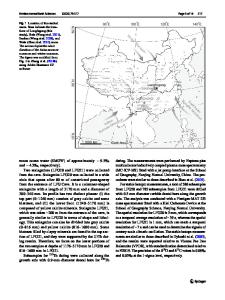Siberia and neighboring regions in the Last Glacial Maximum: did people occupy northern Eurasia at that time?
- PDF / 2,304,930 Bytes
- 14 Pages / 595.276 x 790.866 pts Page_size
- 65 Downloads / 329 Views
ORIGINAL PAPER
Siberia and neighboring regions in the Last Glacial Maximum: did people occupy northern Eurasia at that time? Yaroslav V. Kuzmin 1,2 & Susan G. Keates 3
Received: 20 October 2015 / Accepted: 10 May 2016 # Springer-Verlag Berlin Heidelberg 2016
Abstract An updated analysis of Paleolithic sites in Siberia and the Urals 14C-dated to the coldest phase of the Last Glacial Maximum (LGM), with its timespan currently determined as ca. 23,000–19,000 BP (ca. 27, 300–22,900 cal BP), is presented. It is demonstrated that people continuously occupied the southern and central parts of Siberia and the Russian Far East (up to 58° N latitude), and perhaps sporadically settled regions located even further north, up to 70° N, throughout the LGM. This is in accord with our previous data, but is now based on a larger dataset, and also on a paleoecological analysis of the major pre-LGM archaeological sites in Siberia and the Urals north of 58° N. It is clear that Paleolithic people in northern Eurasia were able to cope with the treeless tundra environment well in advance of the LGM, at least at ca. 34,000–26,000 BP (ca. 38,500– 30,000 cal BP). Therefore, a high degree of adaptation to cold conditions allowed people to survive in Siberia during the LGM.
Keywords Last Glacial Maximum . Paleolithic . Radiocarbon dating . Adaptation . Siberia . Urals
* Yaroslav V. Kuzmin [email protected]
1
Institute of Geology and Mineralogy, Siberian Branch of the Russian Academy of Sciences, Koptyug Ave. 3, Novosibirsk 630090, Russia
2
Laboratory of Mesozoic and Cenozoic Continental Ecosystems, Tomsk State University, Lenin Ave. 36, Tomsk 634050, Russia
3
Düsseldorf 40239, Germany
Introduction The issue of human presence in northern Eurasia—Western/ Central Europe north of the Alps, northern part of Eastern Europe, and Siberia—during the Last Glacial Maximum (LGM), has been intensely debated in the last 15–20 years. The LGM was originally determined as centered around 18, 000 radiocarbon years ago (BP) (e.g., COHMAP 1988) when environmental conditions in the Northern Hemisphere were the most cold and dry for the last 60,000 years, and possibly the last 130,000 years. In later studies, the duration of the LGM was set at ca. 22,000–16,000 BP corresponding to ca. 26,500–19,000 calendar years ago (cal BP) (Clark et al. 2009). This timespan includes several paleoclimatic events reflected in Greenland ice cores: Greenland stadials (GS) 3, 2.2, 2.1b, and 2.1c; and Greenland interstadials (GI) 2.2 and 2.1 (Rasmussen et al. 2014). The coldest conditions were observed during the GS-3 interval dated to ca. 27.5–23.3 thousand years ago (or ka b2k in Rasmussen et al. 2014), which on a radiocarbon time scale is equal to ca. 23,300–19,300 BP (Reimer et al. 2013). Since the beginning of the discussion about the presence of Paleolithic humans in Siberia at the LGM in the late 1970s (Tseitlin 1979), there have been two groups of scholars with opposite opinions. BPessimists^ like Tseitlin (1979), Dolukhanov et al. (2002), Hoffecker (2002,
Data Loading...











